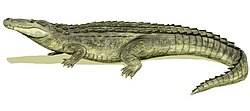| Dollosuchus Temporal range: | |
|---|---|
 | |
| Fossils referred to Gavialis dixoni (now Dollosuchus dixoni) by Richard Owen | |
| Scientific classification | |
| Kingdom: | Animalia |
| Phylum: | Chordata |
| Class: | Reptilia |
| Clade: | Archosauria |
| Order: | Crocodilia |
| Superfamily: | Gavialoidea |
| Family: | Gavialidae |
| Subfamily: | Tomistominae |
| Genus: | † Dollosuchus Swinton, 1937 vide Owen, 1850 |
| Type species | |
| †Dollosuchus dixoni Owen, 1850 | |
| Synonyms | |
| |
Dollosuchus (meaning "Louis Dollo's crocodile") is an extinct monospecific genus of tomistomine crocodilian originally named as a species of Gavialis . [1] It is a basal form possibly related to Kentisuchus , according to several phylogenetic analyses that have been conducted in recent years, [2] [3] [4] and is the oldest known tomistomine to date. Fossils have been found from Belgium and the United Kingdom. [5] It had large supratemporal fenestrae in relation to its orbits, similar to Kentisuchus and Thecachampsa . [6]
Contents
Dollosuchus was originally described on the basis of numerous mandibular fragments found from the Early to Middle Eocene Bracklesham Beds Formation in the United Kingdom. The material cannot be distinguished from other related longirostrine, or long-snouted, crocodilians. A nearly complete skeleton from Belgium (IRScNB 482) discovered in 1915 and described by Swinton in 1937, [5] and referred to Dollosuchus, formed the basis of the new taxon Dollosuchoides densmorei . [4] The holotype, BMNH 26125 and BMNH 26126, is now on display at the World of Kina museum in Ghent, Belgium.


